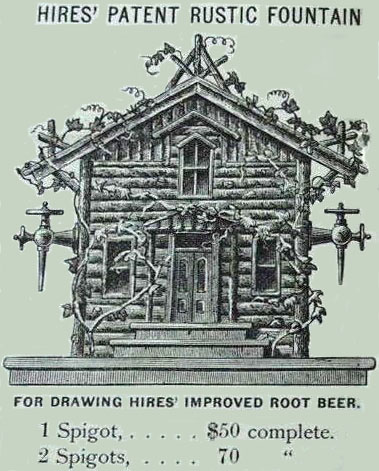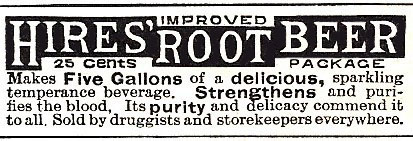1887
IT HAPPENED IN…1887
Railroad building and mergers brought thousands
of new people into Los Angeles.
California’s warm climate and employment opportunities were
highly publicized.
Edison built the first motor-driven phonograph
with sound recorded on wax cylinders.
Free mail delivery was provided in all
communities with a population of 10,000 or larger.
The gap between the poorest and richest Americans
widened. Clothing for
the poor was dark and drab, and men worked in overalls.
The growing middle class lived in comfortable homes crowded
with heavy furniture, thick draperies, and knickknacks.
Newly introduced products and inventions included
pneumatic tires, the multiplex railway telegraph, and “Safety
bicycles” with wheels of equal size.
During 1887 Charles Hires mass-mailed 9.0” x 14.0” flyers to druggists
and storekeepers across the United States, Canada, and Britain promoting
Hires’ Improved Root Beer Packages at wholesale prices.
The mailer included customer and dealer testimonials, an
extensive list of wholesalers, and for the first time, an image of
“Hires’ Patent Rustic Fountain,” modeled after a log cabin.
One spigot models were $50.00, while two spigot models were
$70.00.
Hires’ Patent Rustic Fountain held a supply of
Hires’ Improved Root Beer syrup that was dispensed into glasses, with
carbonated water added from a separate source.
Most likely the side or roof of the log cabin was marked
advertising this was specifically a Hires dispenser.
(Figure 1887-01, Hires’ Patent Rustic Fountain)
The development and introduction of this unique soda
fountain was likely a defensive move by Hires as he attempted to keep up
with his competition.
Accelerated industrial development after the U.S. Civil War included all
aspects of the soda water industry, particularly soda fountains.
A detailed history of soda fountains can be found in John J.
Riley’s chapter about the “Early Years of the Soda Fountain” in his 1958
book, A History of the American
Soft Drink Industry: Bottled Carbonated Beverages, 1807-1957.
Riley stated:
Development of a counter type of device, for
preparation of the carbonated waters and their dispensing, was one
answer, and numerous attempts were made in that direction…
The earliest U.S. patent relating to soda water
apparatus, for which an illustration is now available, is that issued to
Samuel Fahnestock, of Lancaster, Pa., in 1819.
It shows the type of portable tank, or fountain for containing
the carbonated water to be dispensed…The use of the tank type of
‘fountain’ continued through the succeeding years as normal practice…
The earlier popular types of fountain dispensers were
typified by counter draft arms connected with the soda water tank,
concealed and cooled below the counter…Dispensing glasses were kept on
the counter, with a small selection of bottled syrups for filling the
preference of the customer.
Later the syrup bottles were mounted in a caster, or inverted in rings
on a marble slab, with a valve in each bottle for releasing the syrup
into the glass before it was filled from the fountain…
Progress in the retail soda-fountain field starting
about the turn of the century, therefore, centered largely in the soda
fountain unit itself. Most
prominent was the change of the fountain to the type of ‘front service’
which has entirely superseded the ornate marble structures of the
Mid-Victorian era.
Hires placed this small advertisement in
Century magazine in 1887:
(Figure 1887-02,
Century
magazine)
Charles E. Hires Company sales for 1887 were listed
as 191,808 bottles.


